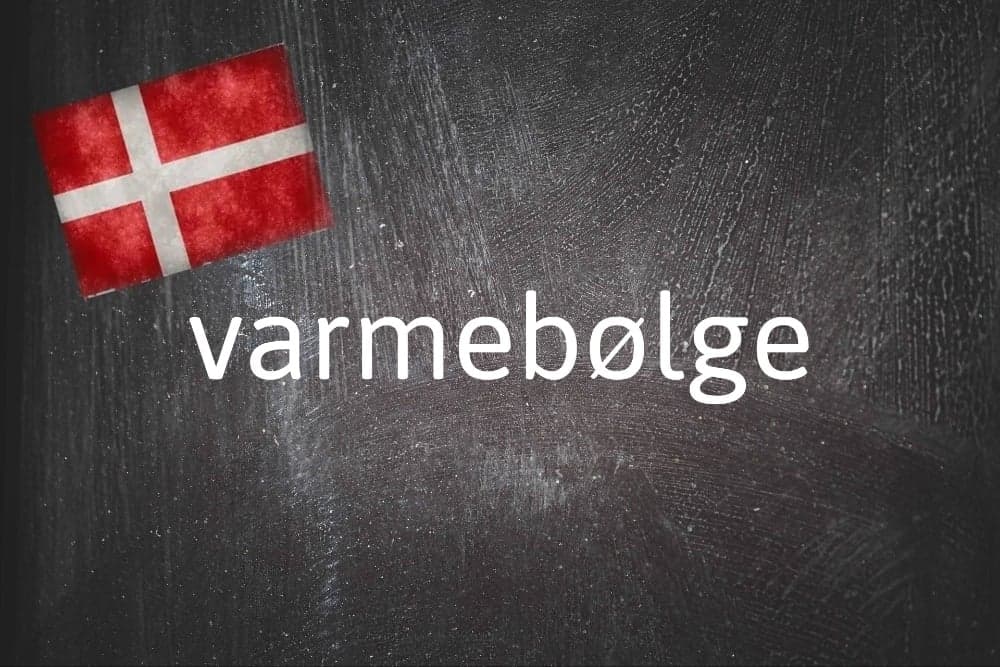Danish word of the day: Varmebølge

Photo by Francesco Ungaro on Unsplash and Nicolas Raymond/FlickR
Here's a Danish word to use when complaining about the hot weather.
What is varmebølge?
Varmebølge means "heatwave" in Danish.
Varme means "heat" or "warmth", and bølge means "wave", so it's an easy translation. You'll sometimes hear hedebølge used too, using another Danish word for "heat". The word varme is the more common of the two, and can be used in situations where you might say either “heat” or “warmth” in English. Hede, on the other hand, implies a more extreme type of heat.
For example, the Danish words for “hot water bottle” and “central heating” both use varme rather than heat (varmedunk and centralvarme or just varmen, respectively) and "hot weather" is varmt vejr but the phrase i kampens hede means “in the heat of the battle”.
Why do I need to know varmebølge?
While the above terms – varmebølge and hedebølge – are synonyms on first glance, there’s an important difference.
Denmark’s national meteorological agency, DMI, defines a varmebølge as a three-day period on which the average highest temperature is over 25 degrees Celsius.
For a hot spell to qualify as a hedebølge, on the other hand, the average highest temperature for the three days in question must exceed 28 degrees Celsius
People from southern parts of Europe might consider either type of Danish heatwave to feel more like regular summer weather – and perhaps this helps explain why extreme weather in southern regions in recent years, related to climate change, has led to speculation Denmark could become an increasingly popular summer destination for foreign holidaymakers.
The phrases also reveal a little about how Denmark’s climate influences language and the way Danes talk about the weather.
READ ALSO: Five Danish phrases you only hear in summer
While almost everyone gets quickly tired of long spells of cool, wet summer weather – like those seen during most of June 2024 – it also doesn’t take much for Danes to begin longing for more moderate temperatures to return once it heats up.
Anything over around 24-25 degrees Celsius is likely to be considered for meget (“too much”) what I would consider a regulation summer temperature of 26 degrees might be described as denne forfærdelige varme (“this dreadful heat”).
Comments
See Also
What is varmebølge?
Varmebølge means "heatwave" in Danish.
Varme means "heat" or "warmth", and bølge means "wave", so it's an easy translation. You'll sometimes hear hedebølge used too, using another Danish word for "heat". The word varme is the more common of the two, and can be used in situations where you might say either “heat” or “warmth” in English. Hede, on the other hand, implies a more extreme type of heat.
For example, the Danish words for “hot water bottle” and “central heating” both use varme rather than heat (varmedunk and centralvarme or just varmen, respectively) and "hot weather" is varmt vejr but the phrase i kampens hede means “in the heat of the battle”.
Why do I need to know varmebølge?
While the above terms – varmebølge and hedebølge – are synonyms on first glance, there’s an important difference.
Denmark’s national meteorological agency, DMI, defines a varmebølge as a three-day period on which the average highest temperature is over 25 degrees Celsius.
For a hot spell to qualify as a hedebølge, on the other hand, the average highest temperature for the three days in question must exceed 28 degrees Celsius
People from southern parts of Europe might consider either type of Danish heatwave to feel more like regular summer weather – and perhaps this helps explain why extreme weather in southern regions in recent years, related to climate change, has led to speculation Denmark could become an increasingly popular summer destination for foreign holidaymakers.
The phrases also reveal a little about how Denmark’s climate influences language and the way Danes talk about the weather.
READ ALSO: Five Danish phrases you only hear in summer
While almost everyone gets quickly tired of long spells of cool, wet summer weather – like those seen during most of June 2024 – it also doesn’t take much for Danes to begin longing for more moderate temperatures to return once it heats up.
Anything over around 24-25 degrees Celsius is likely to be considered for meget (“too much”) what I would consider a regulation summer temperature of 26 degrees might be described as denne forfærdelige varme (“this dreadful heat”).
Join the conversation in our comments section below. Share your own views and experience and if you have a question or suggestion for our journalists then email us at [email protected].
Please keep comments civil, constructive and on topic – and make sure to read our terms of use before getting involved.
Please log in here to leave a comment.